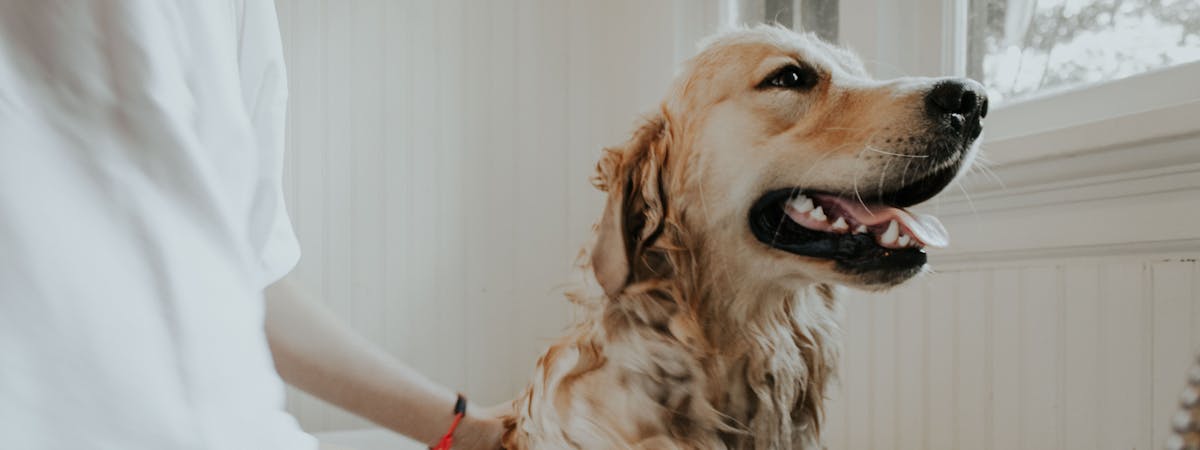Regular grooming is essential for keeping your canine in tiptop condition, so here we’ve put together a guide to dog grooming for beginners. Whether you’re a dog owner or a pet sitter, these tips should help you to prepare for a dog groom and get through the process with as little distress as possible – for both you and the dog!
Trending posts
Purr-use some of the top blogs our members have been loving this month- Top male dog names for your new furry friendGot a new furry family member in your pack? Check…

- Top female dog names for your new fluffy palWelcoming a new pooch into your family? Explore…

- 250+ gray cat names your silver feline will loveRecently welcomed a fluffy gray bundle of joy into…

- What are normal pet sitting rates?Discover the average pet sitting rates for animals…

- Unique dog names to stand out from the packDare to be different with our list of the best…

What is dog grooming and why should I do it?
Dog grooming isn’t just about keeping your pet’s hair in great shape, although that’s a big part of the process. It’s also a chance to trim your dog’s nails and give its teeth and ears a thorough clean. Think of it as whole-body pampering!
As well as keeping your dog’s coat free of tangles and removing parasites and dead hair, grooming gives you a chance to give your pooch a thorough check-up. While brushing, you should check the dog’s skin for any sign of infection or irritation, as well as look for any problems with its eyes, ears and paws.
Most importantly, grooming provides an opportunity to bond with your dog and give the adorable canine some much-welcomed love and attention. But how do you groom a dog?
Basic equipment and supplies for dog grooming
When it comes to dog grooming for beginners, there are a few simple supplies you’ll need.
Brush
Top of the list is a good quality brush. The kind of brush you’ll need will depend on the texture and length of the dog’s coat. Pin brushes should be used for long-haired breeds – these brushes have long metal bristles with round ends. Bristle brushes (without rounded ends) tend to be used for dogs with shorter hair.
In addition, you might want to get a mat rake or mat splitter to deal with matted hair. A wide-toothed comb can also be useful for detangling knots.
Dog shampoo
Make sure to get a shampoo (or a dog dry shampoo) that is specially formulated for dogs. Shampoos designed for humans can sometimes contain ingredients that will irritate your pet’s skin.
Dog toothbrush and toothpaste
There are a range of toothbrushes that are specially designed for dogs, and it’s also important that you use a dog toothpaste – human toothpastes contain ingredients such as xylitol that are toxic to dogs.
Towels for drying
You’ll need a towel or two for drying off your dog after a bath. There are also special dog hair dryers, but if you don’t have one of those, you can use a regular hairdryer set to cold.
Grooming scissors or electric clippers
You might not be giving your dog a full trim – it’s best to leave that to the professionals – but you might want to carefully trim the hair around its eyes, mouth and ears if it’s getting too long.
Nail clippers
There are various specially designed clippers for trimming dogs’ nails, some of which have a guard to stop you accidentally trimming the nails too short.
Otic solution and gauze
For cleaning out your dog’s ears, you’ll need some otic solution and a piece of sterile gauze or sponge to wipe it off.
Cotton wool
Handy for cleaning around your dog’s ears while it’s having a soak! Cotton wool is also useful for gently cleaning around the eyes.
Easy steps to grooming a dog
Welcome to dog grooming for beginners! Here’s a step by step guide to the various different aspects of grooming, from brushing to ear cleaning.
Taking care of the skin and coat
How often you brush your dog depends somewhat on the length of its hair, but generally you should aim to brush its coat every couple of days. Use an appropriate brush – a pin-headed brush for long hair or a bristle brush for shorter hair – and gently tease out any tangles.
If you come across any particularly matted patches, hold the hair between the knot and the dog’s skin while you work at the tangle – doing this will stop you from pulling on the hairs’ roots, a guaranteed whelp-inducer. You might want to switch to a wide-toothed comb or a special mat rake or mat splitter for especially matted hair.
You might assume that you should brush the dog’s hair after giving it a bath, but in fact the opposite is the case. It’s much easier to detangle knots and brush out the fur before bathing than afterwards.
Keep an eye out for burrs or foreign objects while brushing, and check the condition of your dog’s skin as you go. Brushing can also be a good opportunity to check for fleas on dogs, or other parasites. If the dog’s hair is getting in its eyes or mouth, you might want to give it a quick trim with some grooming scissors or clippers at this point.
Dog bath
Dogs don’t tend to need baths very often – in fact, washing them too frequently can dry out their skin and coat. Generally you should only wash your dog around once a month, or even less. Although of course, if the naughty pooch has been playing in sticky, filthy mud, an emergency bath could be on the cards.
Partially fill a bath or basin with warm water, and wet the dog’s coat using a shower or by just splashing it with your hands. Then gently rub in some dog shampoo: start at the neck, then work your way backwards to the tail. Once you’re done, rinse with warm water. And prepare to get wet – many dogs dislike baths, so expect lots of splashing and energetic coat shakes!
Afterwards, rub the dog down with a towel and/or use a hairdryer set to cold.
Trimming the nails
A dog’s nails don’t need trimming that often – possibly once a month, or perhaps even less. A telltale sign that a dog’s nails are too long is that you can hear them clicking on the floor when it walks, and the nails touch the ground when the dog is standing up.
Approach nail trimming with caution – a dog’s nail contains a blood vessel known as the ‘quick’, and trimming the nail too short can sever this, causing bleeding. You can often see where the quick ends on dogs with clear nails, but it’s impossible to see on dogs with black nails. When trimming, only snip off the very tip of the nail. If you do accidentally snip the quick, use a styptic powder to stop the bleeding.
It’s best to get someone else to show you how nail trimming is done before you try it yourself – and be aware that most dogs will squirm throughout the process, making it doubly hard. If you’re not confident about trimming a dog’s nails yourself, don’t attempt it, and take the dog to a professional groomer instead.
Brushing the teeth
You should brush your dog’s teeth fairly frequently – around once a week, or more often – to maintain healthy teeth and gums.
Make sure to use specially formulated dog toothpaste, and get the dog to lick the toothpaste first by offering some on your finger or on the dog’s toothbrush. Then squeeze some toothpaste on the brush, gently lift the dog’s lips, and brush for a few seconds
Ear and eye cleaning
Your dog’s ears should be cleaned around once a month – after the monthly bath is a good time. This is easily done by holding your dog’s head and then applying some otic solution into the ear. Wipe off any excess solution using a piece of sterile gauze or sponge.
You should only clean your dog’s eyes if they are showing excess discharge. Gently mop up any discharge using a moist piece of cotton wool. If the dog’s eyes are particularly wet or weeping, it may be best to consult your vet to rule out any underlying problems.
Grooming puppies
Puppies should be introduced to grooming at a fairly young age – usually around 16 weeks. Keep initial grooming sessions short, and make sure to lavish praise and love on the puppy as you go. The aim is to keep them feeling calm and comfortable, and to make grooming a part of the puppy training process.
If the puppy is showing real distress, then take a break or cut the grooming session short. The same rule applies to grooming adult dogs – grooming should be a relaxing process for both parties, so don’t try to force the dog to continue or scold it.
Grooming is a fantastic opportunity to bond with your doggy friend, as well as to give them a thorough check-up. Make sure to shower your dog with praise as well as water throughout!
Related article: 5 Shih Tzu haircut ideas
Best dog brushes for shedding, revealed
Got a particularly hairy hound? We’ve rounded up a list of 10 of the best dog brushes for shedding - to help you tackle that fur before it ends up on your floor...

